Symbols
ON ST. SAVA DAY, IN HERCEG-NOVI, CONSECRATED THE MONUMENT TO A FAMOUS COUNT
Sava Vladislavić Returned Home
Many threads intertwined here happily in a way that is exciting and festive. With Sava, in Savina, on St. Sava Day. And on a little square in Topla, below the church, on that day a monument was unveiled to another great Sava – Sava Vladislavić. Made of bronze, on white granite, work of sculptor Đorđe Lazić, the same as the one already erected in Gacko, Sremski Karlovci and St. Petersburg. It was the occasion for us to come again to this beautiful and important town in Herzegovina
By: Dragan M. Ćirjanić
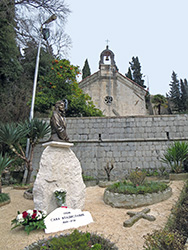 You have to see that monastery – Zoran Šabanović was persuading us needlessly. You have to see that monastery – Zoran Šabanović was persuading us needlessly.
With brothers Vukomanović, offspring of great family of Vladislavić, whose guest I was, we came by ”Air Serbia” via Tivat to Herceg Novi, to attend the unveiling of a monument to the great Sava Vladislavić fromHerzegovina. This journey was a kind of pilgrimage. The sun shone over the surrounding mountains covered with snow, giving an air of loftiness to everything. St. Sava Day is tomorrow.
Sun and cold were appropriate frame work the ambience filled with hidden drama. Lovćen was rising in distant mist. We also visited the Russian Cemetery on Savina, with the Chapel of St. Admiral Ušakov, the only church dedicat6ed to this righteous warrior. Admiral Fjodor Ušakov did not lose a single battle in his glowing career. He helped Montenegrins in battles against Napoleon, and freed Boka from the French.
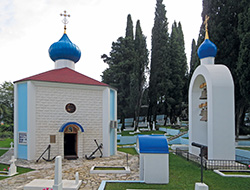 Herceg Novi was also the first harbor-refuge in which white immigrants arrived on ships from Odessa during the civil war in Russia. Some stayed in this city... We were looking forward to meting the man who arranged all this and revived the memory of heroic and tragic era. Painter and seaman, Aleksandar Beljakov lives and paints in Herceg Novi. Herceg Novi was also the first harbor-refuge in which white immigrants arrived on ships from Odessa during the civil war in Russia. Some stayed in this city... We were looking forward to meting the man who arranged all this and revived the memory of heroic and tragic era. Painter and seaman, Aleksandar Beljakov lives and paints in Herceg Novi.
Roads to the hill above Herceg Novi was carved by gullies and Zoran’s Lada Niva began to show its power. After half an hour of drive, on a plateau below Mrčeva greda, we spotted several stone houses of the village of Bunovići. Inaccessibility and uncomfortable road only enhanced the impression of beauty of this little hamlet in stone.
Not far, on an elevation, there was the monastery of St. Petka (the Roman) where two nuns stayed. They came from Russia. The monastery dates back to the Byzantine period. Nearby is a part of a Byzantine road that passed through here. Near the monastery there is a preserved amphitheatre with clear stone cascades. As if the archaic beauty of the landscape and people, worthy of painters such as Böcklin or Caspar David, enjoyed in noble anonymity.
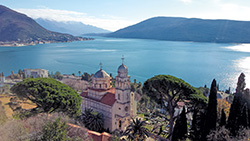 In the recently renovated residence, two Russians maintained the life of prayers with unusual enthusiasm. They speak Serbian well, although they had been here since June last year. The spirit of prayer of our Church attracted them and they feel good here. Sisters Nektarija and Georgija are educated and they move easily in the conversation, which developed spontaneously, about the origin of Slavs and linguistic issues of European peoples. princes of Moscow and Kiev, Varjazi, Rjurikovići and Romanovs, Vikings and Germans, Serbs and the Nemanjić dynasty, were present and alive in the conversation in the hills above Novi, in that sunset, before the St. Sava Day. Many clichés from Russian history were developed there. There is no doubt about Slavic power and the future. These are facts, the reality that we only need to reveal to others, victims of historical delusions and misconceptions. Enchanted with this unexpected encounter and confirmation with our own beliefs, we parted until the following day. Zoran Šabanović, director of the Water Supply of Herceg Novi, a benefactor and good spirit of the Serbianship of Herceg Novi, was proud while we were descending down to the sea. In the recently renovated residence, two Russians maintained the life of prayers with unusual enthusiasm. They speak Serbian well, although they had been here since June last year. The spirit of prayer of our Church attracted them and they feel good here. Sisters Nektarija and Georgija are educated and they move easily in the conversation, which developed spontaneously, about the origin of Slavs and linguistic issues of European peoples. princes of Moscow and Kiev, Varjazi, Rjurikovići and Romanovs, Vikings and Germans, Serbs and the Nemanjić dynasty, were present and alive in the conversation in the hills above Novi, in that sunset, before the St. Sava Day. Many clichés from Russian history were developed there. There is no doubt about Slavic power and the future. These are facts, the reality that we only need to reveal to others, victims of historical delusions and misconceptions. Enchanted with this unexpected encounter and confirmation with our own beliefs, we parted until the following day. Zoran Šabanović, director of the Water Supply of Herceg Novi, a benefactor and good spirit of the Serbianship of Herceg Novi, was proud while we were descending down to the sea.
MEMORY OF GREAT WORKS
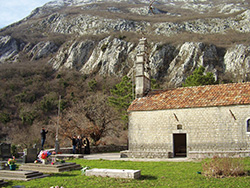 With the cross of Saint Sava in his hands, made of cut glass lined with silver, metropolitan of Montenegro and the Littoral, Mr. Amfilohije, walked at the head of the procession through forest road toward the little old church of Saint Sava above Savina Monastery. Slowly, with the hum of prayers, the song dedicated to Saint Sava Nemanjić was rising. With the cross of Saint Sava in his hands, made of cut glass lined with silver, metropolitan of Montenegro and the Littoral, Mr. Amfilohije, walked at the head of the procession through forest road toward the little old church of Saint Sava above Savina Monastery. Slowly, with the hum of prayers, the song dedicated to Saint Sava Nemanjić was rising.
It was an image full of symbolism in the murky times in which we live.
In the prayer speech, lofty and strong, the Bishop called the politicians and separatists to their senses, to return to the loftiness and the vertical of Serbian spirituality.
Inspired by Sava’s work, he pointed out the authenticity and greatness of Serbian decisive choice with respect to the forces of this world and in issues of the Holy Spirit.
Strong and handsome, men of Boka, Montenegrins, Herzegovians with their families, gathered around their Bishop, were the image of beauty of Serbian race and contained strength of Serbian congregation. The entire Savina, wherever one would look, excludes every banality and calls to loftiness and holiness. I noticed, from the side, the appearance of my acquaintance Krsta Martinović, with famous origin and caring face. He smiled painfully to my question about how he was, and said quietly:
– Big crowd by very few people.
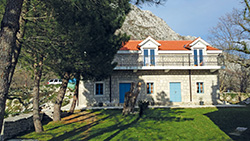 He wanted to express the tragedy and transience of this state of affairs. Serbian divisions pained him. He quietly withdrew before the end of the service into his proud loneliness. He wanted to express the tragedy and transience of this state of affairs. Serbian divisions pained him. He quietly withdrew before the end of the service into his proud loneliness.
On Topla, below the Church of Holy Ascension and Church of St. George, a monument was unveiled to Count Sava Vladislavić, who in a very unusual way connected the fate of Serbia and Russia. As an important courtier of Peter the Great, participant in the most crucial endeavors of the Russian Emperor, he enjoyed great honors in Russia.
He was an advisor and quartermaster of the Russian army in the Battle of Poltava, where the growing appetites of the ferocious Swedish king Carl XII were broken. He also organized a campaign against Turks, which ended in a peace treaty, with him being one of the signatories. The emperor sent him to Rome with a task to negotiate with Pope Clement XI about the concordat. Pope’s death interrupted the negotiations. As an educated man with good taste, he was entrusted with procurement of many valuable works of art and equipment for the Russian court. He was one of the founders of the powerful Russian intelligence service. He took care about education of Russian cadets in navy academies of Europe and contributed to the development of Russian imperial navy fleet.
From one of his journeys to Constantinople he brought a purchased slave as a gift to Peter the Great, Hannibal, an Abyssinian, who was baptized and educated by the Emperor. He was the great-grandfather of Alexander Pushkin, the great poet.
KJAHTA REMEMBERING ITS FOUNDER
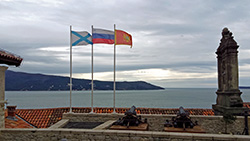 Sava experienced the climax of the service on the court when he was sent, as a special imperial emissary, to negotiate with the Chinese emperor about the 6,000 kilometers long border between Russia and China. In difficult three-years long negotiations, Sava successfully completed the task, signed the agreement on delineation, and that border, with minor changes, exists even today. During his stay in the East, he created maps of those areas, so he could be regarded as the first Serbian cartographer. He built several military fortifications along the border, and in one of them, Troickosavsk, named after the Holy Trinity, he also built a church dedicated to Saint Sava of Serbia. The church disappeared in the fire in the late 19th century, and was rebuilt into a larger church of Holy Trinity, which still stands today, half-demolished. After the Revolution, it was turned into a museum, survived several fires in the 1960’s, and its walls later served as a shooting range for soldiers. Sava experienced the climax of the service on the court when he was sent, as a special imperial emissary, to negotiate with the Chinese emperor about the 6,000 kilometers long border between Russia and China. In difficult three-years long negotiations, Sava successfully completed the task, signed the agreement on delineation, and that border, with minor changes, exists even today. During his stay in the East, he created maps of those areas, so he could be regarded as the first Serbian cartographer. He built several military fortifications along the border, and in one of them, Troickosavsk, named after the Holy Trinity, he also built a church dedicated to Saint Sava of Serbia. The church disappeared in the fire in the late 19th century, and was rebuilt into a larger church of Holy Trinity, which still stands today, half-demolished. After the Revolution, it was turned into a museum, survived several fires in the 1960’s, and its walls later served as a shooting range for soldiers.
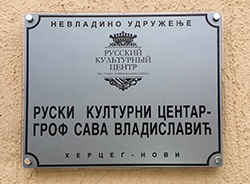 Modern Russia and local government want to restore the temple, and Kjahta, which is the new name of Troickosavsk, preserves and praises the name of its founder. There is also a desire to give back to the city its old name of Troickosavsk. Modern Russia and local government want to restore the temple, and Kjahta, which is the new name of Troickosavsk, preserves and praises the name of its founder. There is also a desire to give back to the city its old name of Troickosavsk.
Sava Vladislavić wrote The Secret Report on China for the needs of the Russian court. Even today it stands as an exemplary work of statesmanship, which, along the entire Sava’s work, bears witness to the continuity of Serbian nation-building spirit.
In order to familiarize the Emperor with the Slavic issue in the Balkans, Sava translated into Russian The Kingdom of Slavs, a famous work by Mavro Orbin. Vladislavić should be thanked because the ”Eastern question”, the question of liberation of Serbs, was clearly formulated in the Russian court. From those times, this Russian attention has lasted until the present day.
Sava Vladislavić was buried in the Church of Holy Annunciation of Alexander Nevsky Lavra in St. Petersburg, in which members of the imperial family had already been buried. Later, great Russian general Aleksandar Suvorov will be buried next to him. All this clearly shows how respected and meritorious Sava Vladislavić was in Russia.
On the little city square in Topla, Serbian flag was covering the bronze coffin, on white granite, the work of sculptor Đorđe Lazić. Among the invitees, in addition to the ambassador of Russia in Montenegro, Mr. Andrej Nesterenk, who unveiled the monument, there was also Mrs. Zelina Medoeva, vice-president of Russian ”Andrej Prvozvani” Foundation from Russia and the Centre National Glory of Russia, which emphasized the significance of count Save Vladislavića for Russia. Metropolitan Amfilohije, with the cross of Saint Sava, consecrated the monument which now appears as if it is guarding, together with the monument to Njegoš in its vicinity, the western border of Serbianship.
A META-HISTORICAL GATHERING
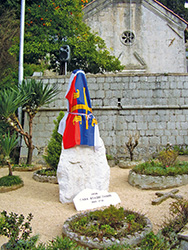 Saint Sava Day was the perfect time for such a return to his hometown. The same monuments to Sava Vladislavića are already erected in Gacko, Sremski Karlovci and St. Petersburg. In the city of Kjahta, in Russia, they are planning to soon build a monument on a larger scale. Together with restoration of the church in Troickosavsk, it will be a fully closed circle of forces that are brought together, with his life and work, by this exceptional Serb, from the East to the West of the Christian Orthodox Empire. A clear and sufficient road sign to contemporary Serbia as to what it would be doing in the reconstruction of its state. Saint Sava Day was the perfect time for such a return to his hometown. The same monuments to Sava Vladislavića are already erected in Gacko, Sremski Karlovci and St. Petersburg. In the city of Kjahta, in Russia, they are planning to soon build a monument on a larger scale. Together with restoration of the church in Troickosavsk, it will be a fully closed circle of forces that are brought together, with his life and work, by this exceptional Serb, from the East to the West of the Christian Orthodox Empire. A clear and sufficient road sign to contemporary Serbia as to what it would be doing in the reconstruction of its state.
Former ”Belvedere” Restaurant, above the Fortress of Herceg Novi, the terrace of which has a view that calls for dreaming and from where I once embarked into the water of marriage, is now the newly opened Russian Cultural Centre ”Count Sava Vladislavić”. There is already a significant Russian colony in this city.
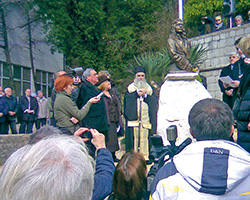 Saint Sava Academy, in the full auditorium ”Park”, where the introductory speech was given by Metropolitan Amfilohije, was crowned by an inspired performance directed by Ivana Žigon. Njegoš’ verses and thoughts, accompanied by light and sound effects, which complemented the tragic feeling of the poet’s vision, were falling on us like gold dust, turning to a certain extent the prose of our lives into an epic of history. Essentially, very little has changed. Not losing a bit of its archaism, the sound of gusle evoked next to the Bishop the image of Saint Sava and the image of Obilić. It was a symbolically strong meta-historical gathering. Saint Sava Academy, in the full auditorium ”Park”, where the introductory speech was given by Metropolitan Amfilohije, was crowned by an inspired performance directed by Ivana Žigon. Njegoš’ verses and thoughts, accompanied by light and sound effects, which complemented the tragic feeling of the poet’s vision, were falling on us like gold dust, turning to a certain extent the prose of our lives into an epic of history. Essentially, very little has changed. Not losing a bit of its archaism, the sound of gusle evoked next to the Bishop the image of Saint Sava and the image of Obilić. It was a symbolically strong meta-historical gathering.
Radiant, impassioned and united with the spirit of Saint Sava, we departed into the night.
If Serbs today would really fathom the work and significance of Saint Sava and his powerful statesman’s role, as Sava Vladislavić understood it... Uh, as Ezra Pound would say, I cannot sleep all night because of that thought.
***
Unbreakable Ties
His entire life, Sava Vladislavić maintained connections with the rebels from Herzegovina and Bishop Danilo, with church dignitaries and monasteries, helping them generously. Upon Sava’s advice, Emperor Peter the Great sent teacher Maxim Suvorov to Sremski Karlovci, who there opened the first Serbian school there, which is regarded the beginning of educational activity in this city.
***
Beljakov
Aleksandar Beljakov stands out among the Russians in Herceg Novi. An admiral’s son, and himself a navy officer, he is today dedicated to painting. Based on the motifs and palette of colors, he is searching for his place among the painters of Mannerism. He placed his studio between the bell tower of the Church of Saint Jerome and little church of Saint Leopold. Having restored the stone structure of dilapidated walls of the church, he built a beautiful gallery and a corner decorated with huge anchors and cannons. A true watch tower for this unusual man.
|
